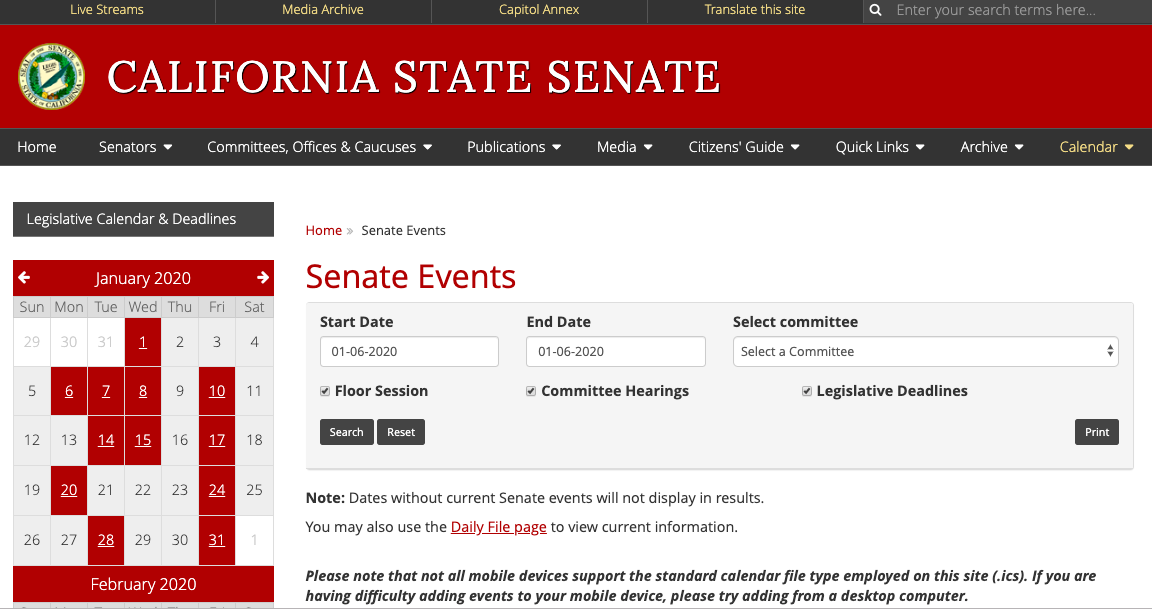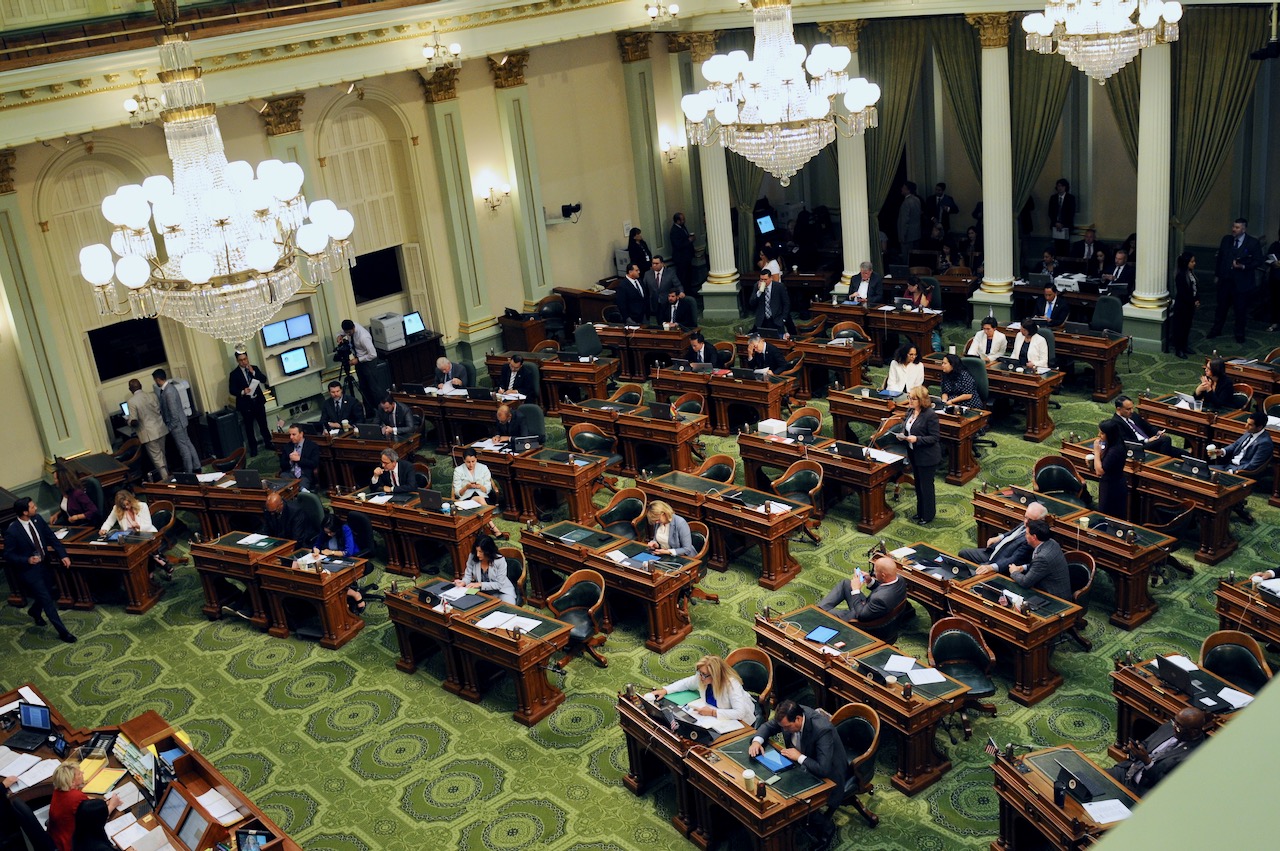
Capitol Stairscase. (Kevin Sanders for California Globe)
Legislative Lingo
The Queen’s English does not apply
By Chris Micheli, September 27, 2019 6:05 am
It probably does not come as a surprise, but those working in and around California’s Capitol use a number of terms or “lingo” to describe aspects of the legislative process. The following is a compilation of some of the more common terms used in the legislative process.
41st Senator — While there are 40 members of the Senate, due to the power of some staff in the upper house, there are a few of them who are viewed as being almost as powerful of the elected members of the Senate.
28.8 — This is a Senate Rule that allows the Senate Appropriations Committee Chairman to waive a hearing and report a fiscal bill out of committee and to the Floor because there is very little state fiscal impact for the bill.
29.10 — This is a Senate Rule that allows the Senate Rules Committee to refer a bill to a policy committee for a hearing if the bill has been substantially amended.
77.2 — This is an Assembly Rule that allows the Speaker to refer a bill to a policy committee for a hearing if the bill has been substantially amended.
Across the Desk — Bills when introduced and amendments to bills are placed “across the desk” which is an official act of introducing bills or making amendments to existing bills.
B.C.P. — This is an acronym for the term “Budget Change Proposal” which is a document prepared by a State agency and the Department of Finance to propose and document budget changes to maintain the existing level of service or to change the level of service.
Blue Pencil — This is a term often used to refer to the Governor’s ability to line-item veto items of appropriation in budget or appropriation bills.
Caucus — A caucus can refer to a group of legislators (e.g., the Democratic Caucus) or a private meeting of a political party.
Chapter Out — This is a phenomenon when a law’s provisions override any conflicting provisions in existing law, thereby chaptering out the earlier law.
Companion Bill — This is when two bills identical in wording are introduced in each house of the Legislature.
District Bill — This is a measure that was introduced by a legislator for his or her district, generally affecting only that particular legislative district.
Double Join — This refers to language added to a bill that makes its passage contingent upon another bill’s passage to avoid one bill chaptering out the other bill.
Effective Date — This is the date that a measure takes effect. It is January 1 of the following year, unless the bill has an urgency clause or a different specified date.
Engrossment — This is the final processing of a bill by the clerk of the house before it is sent to the governor for action and refers to when the text of the bill is checked for errors.
Enrollment — This is the point where the bill is sent to the governor.
Fiscal Committee — This is either the appropriations or budget committees in the Senate or Assembly. In the Senate either the Appropriations Committee or the Budget and Fiscal Review Committee and, in the Assembly, the Appropriations Committee or the Budget Committee.
Gut and Amend — This refers to when amendments to a bill remove the current contents in their entirety and replace them with different provisions which are unrelated to the original contents of the bill.
Held in Committee — This is when a measure was not voted upon because it was likely to fail passage, and a vote is not taken on the measure.
Hijack — This refers to when a member takes over another member’s bill in the legislative process, amends different language into the bill, and uses it as their own vehicle.
Hostile Amendments — These are amendments that are proposed by another Member in Committee or on the Floor that are not supported by the bill’s author.
Inactive File — A bill can be placed on the Inactive File on the Assembly Floor or Senate Floor at either the bill author’s request or because of a procedural motion.
Journal — This is the official record of the proceedings of the Senate and Assembly.
May Revise — The Governor is required to update his or her January budget proposal after the April tax receipts are available.
Mock up — This is an unofficial copy of a bill with proposed amendments so that interested parties and other legislators can examine the bill as it will be amended.
Move a Call — This refers to a parliamentary procedure that delays the announcement of the vote on a measure. A call must be lifted in order for a final vote to be recorded.
Omnibus Bill — This is a major piece of legislation that contains numerous provisions.
On Call — A measure that has been heard but did not garner enough votes for passage is then placed “on call” while the author attempts to garner additional votes.
Pass on File — A bill author can request a measure pending on the Assembly or Senate Floor to not be taken up but retain its place on the Daily File.
Put Over — A measure can be put over to a subsequent hearing either at the request of the author or the committee.
Reconsideration — This occurs when a measure or motion has not been successful the author of maker of the motion is afford another opportunity to have his or her bill or motion considered.
Rule Waiver — This refers to when a specific Assembly Rule, Senate Rule, or Joint Rule is waived, which requires a formal request and approval.
Sponsor — This refers to the legislator, private individual or interest group who developed a piece of legislation and advocates for its passage.
Spot Bill — This is the term used to describe a measure that contains a non-substantive change. It is usually a placeholder measure that will be amended at a later date.
Sunset — This is a provision in a bill that specifies a date when the statutory provision(s) is repealed.
Suspense File — This is the process used in the Senate and Assembly Appropriations Committees for holding bills in place over a specified dollar amount.
Taken Off Calendar — This occurs when a measure is no longer on a committee’s upcoming hearing schedule.
Third House — This is another term for lobbyists or governmental advocates.
Two-year Bill — This is when a bill that did not pass out of its house of origin before the specified deadline in the first year of the two-year legislative session and is carried over to the second year of the Session. If the bill does not clear the second year deadline, then the measure has officially failed passage.
Urgency Clause — This is a provision in a bill that states the bill will take effect immediately upon enactment. The clause must specify a reason for the need to take effect immediately.
Veto — The Governor has the power to veto a bill, which prevent the bill from taking effect.
W.O.R.F. — This is an acronym for the phrase “without reference to file.” A measure that is not listed in the official agenda of the Assembly or Senate would have to be taken up “without reference to file”, which requires suspending the orders of the day.
While there are hundreds of terms used in the California legislative process, including many more used in the state budget process, the aforementioned ones are some of the lingo used regularly in Capitol proceedings.
Chris Micheli is a Principal with the Sacramento governmental relations firm of Aprea & Micheli, Inc. He also serves as an Adjunct Professor at McGeorge School of Law in its Capital Lawyering Program.
- California Department of Child Support Services - December 24, 2025
- Mistakes in Legal Pleadings - December 23, 2025
- The Division of Property Concerning Retirement Plan Benefits - December 23, 2025




